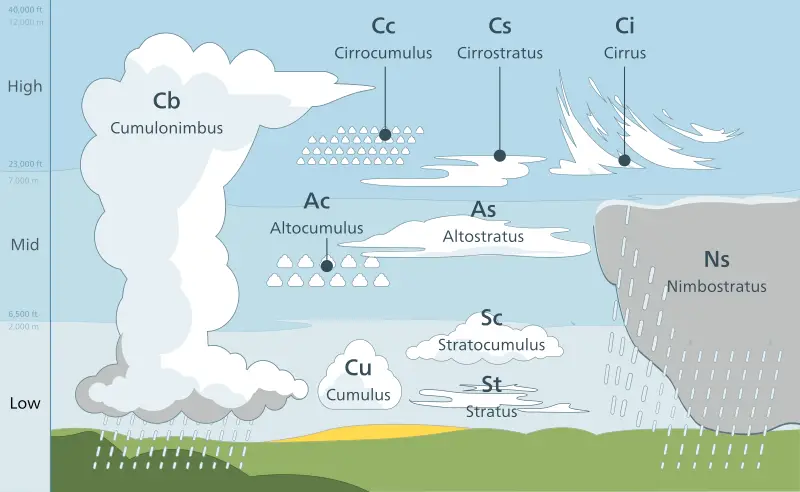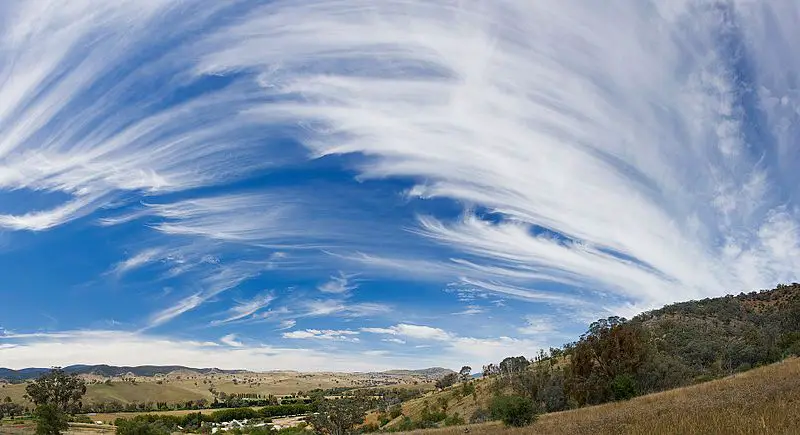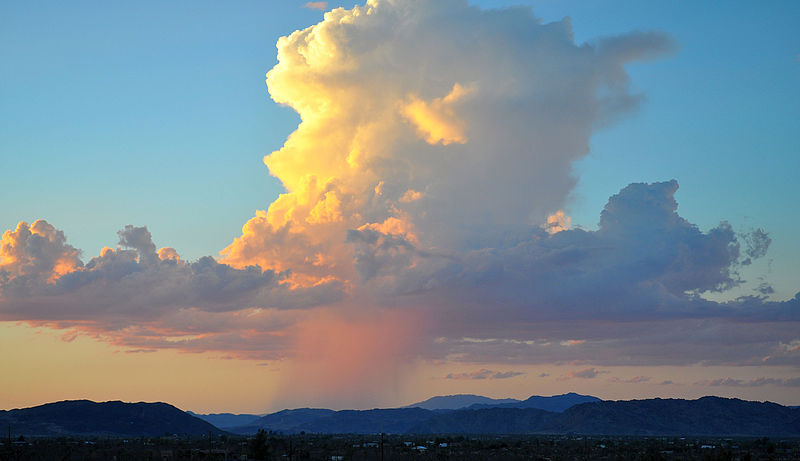What are clouds?
Clouds, whether they are white and fluffy or dark and threatening, are made up of large collections of tiny particles of frozen water. The formation of clouds is caused by the warm air that rises up into the higher layers of the Earth’s atmosphere and then cools down rapidly.
In general, all of the air in the five layers of the Earth’s atmosphere contain some amount of water vapor, and this vapor becomes icy when it is rapidly cooled by warm air reaching higher levels in the atmosphere.

The more warm air that rises, the more air there is to go through this cooling down process and create the icy particles that become clouds.
Types of clouds: Level in the atmosphere
It is not uncommon to describe clouds in terms of where in the atmosphere, or in which level, they form. Clouds are considered to fall into the high level category when they form at 20,000 feet or higher. The names of these clouds usually begin with “cirro.”
Clouds are considered to fall into the middle level category when they form within the range of 6,500 feet and 20,000 feet. The names of these clouds usually include the word “alto.”
Clouds are considered to fall into the low level category when they form at 6,500 feet or lower. The names of these clouds usually include the word “stratus.”

Types of clouds: Appearance
Within the three different levels of cloud categories, there are additional subtypes. For instance, high level clouds include cirrus, cirrocumulus, and cirrostratus clouds.
Cirrus clouds are very thin, and appear during nice, sunny weather. Cirrocumulus are the big white fluffy clouds, and cirrostratus clouds appear flat on the bottom and cover up the sky, leading to a cloudy, overcast day that indicates probable rain in the next few days.
Medium level clouds include the altocumulus clouds, which are white and puffy clouds similar to cirrocumulus, except lower in the sky and smaller. Lower level cloud types include the nimbostratus, stratus, stratocumulus, cumulus, and cumulonimbus.
Nimbostratus clouds are big and dark, and usually indicate rainfall or snowfall. Stratus clouds appear to be flat and cover wide spans of the sky, often gray in appearance and indicating light rain.
Stratocumulus clouds are puffy, but gray, and might bring a small amount of rain. Cumulus clouds are large, white, fluffy clouds that generally appear in nice, sunny weather.
Finally, cumulonimbus clouds are known to range between low and high levels, and are commonly associated with very large storms, including thunderstorms, a lot of rain, tornadoes, and hail.
Additional information about clouds
Fog is what happens when clouds form along the ground. Clouds often don’t appear to be moving, but in fact they can travel up to 100 miles per hour, especially cirrus clouds at high levels in the atmosphere.
Airplanes can leave harmless trails of white clouds, made of vapor, behind them. These are called contrails, and they are long, skinny, and rope-like in appearance.
Not all planets have atmospheres, but the ones that do also form clouds, such as Venus and Jupiter.

Questions:
- What are clouds made of?
- What causes cloud formations?
- What kinds of clouds form at high levels of atmosphere?
- What are nimbostratus clouds?
- What is fog?
Answers:
- Clouds are made up of large collections of tiny particles of frozen water.
- The formation of clouds is caused by the warm air that rises up into the higher layers of the Earth’s atmosphere and then cools down rapidly.
- High level clouds include cirrus, cirrocumulus, and cirrostratus clouds.
- Nimbostratus clouds are big and dark, and usually indicate rainfall or snowfall.
- Fog is what happens when clouds form along the ground.